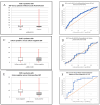Higher NLR Values Can Predict Gram-Negative Spontaneous Bacterial Peritonitis and a High In-Hospital Mortality Rate in Patients with Spontaneous Bacterial Peritonitis
- PMID: 41010305
- PMCID: PMC12470773
- DOI: 10.3390/life15091363
Higher NLR Values Can Predict Gram-Negative Spontaneous Bacterial Peritonitis and a High In-Hospital Mortality Rate in Patients with Spontaneous Bacterial Peritonitis
Abstract
Background: Spontaneous bacterial peritonitis (SBP) represents a significant complication of liver cirrhosis; Gram-positive bacteria (GPB) predominance was recently noted in some areas, with increased antibiotic resistance. Etiology and mortality prediction are important in culture-negative SBP and for empirical antibiotherapy before the arrival of culture results.
Methods: A retrospective study was performed on patients with cirrhosis and ascites admitted between 2018 and 2024, divided into culture-positive SBP (Gram-positive and Gram-negative), culture-negative SBP, and non-infected ascites. The NLR (neutrophil-to-lymphocyte ratio) accuracy for the prediction of SBP and in-hospital mortality was estimated using ROC analysis.
Results: Overall, 45 culture-positive SBP, 28 culture-negative SBP, and 600 control ascites were diagnosed; Gram-positive SBP represented 60%; median NLR values were significantly higher in patients with Gram-negative compared with Gram-positive SBP (8.79 in Gram-negative versus 3.92 in Gram-positive SBP, AUC 0.752, p = 0.003); and a limited role in SBP prediction was recorded (AUC 0.642, p = 0.003), with no difference between culture-positive and culture-negative SBP. The NLR median values were higher for patients who died in hospital in all patients with cirrhosis, in SBP, and culture-positive SBP, but not in culture-negative SBP.
Conclusions: Higher NLR values were associated with Gram-negative SBP etiology and with in-hospital mortality in all cirrhosis, in SBP, and especially in culture-positive and Gram-negative SBP cases. High NLR values can predict the Gram-negative etiology in patients with an ascitic neutrophil count above 250/mm3, which can be used to guide empirical antibiotherapy until cultures are available or in culture-negative SBP.
Keywords: Gram-negative bacteria; Gram-positive bacteria; antibiotic susceptibility; spontaneous bacterial peritonitis.
Conflict of interest statement
The authors declare no conflicts of interest.
Figures





References
-
- Ascione T., Di Flumeri G., Boccia G., De Caro F. Infections in patients affected by liver cirrhosis: An update. Infez. Med. 2017;25:91–97. - PubMed
-
- Piano S., Singh V., Caraceni P., Maiwall R., Alessandria C., Fernandez J., Soares E.C., Kim D.J., Kim S.E., Marino M., et al. Epidemiology and Effects of Bacterial Infections in Patients with Cirrhosis Worldwide. Gastroenterology. 2019;156:1368–1380.e10. doi: 10.1053/j.gastro.2018.12.005. - DOI - PubMed
-
- Voicu M.N., Popescu F., Florescu D.N., Rogoveanu I., Turcu-Stiolica A., Gheonea D.I., Iovanescu V.F., Iordache S., Cazacu S.M., Ungureanu B.S. Clostridioides difficile Infection among Cirrhotic Patients with Variceal Bleeding. Antibiotics. 2021;10:731. doi: 10.3390/antibiotics10060731. - DOI - PMC - PubMed
LinkOut - more resources
Full Text Sources

